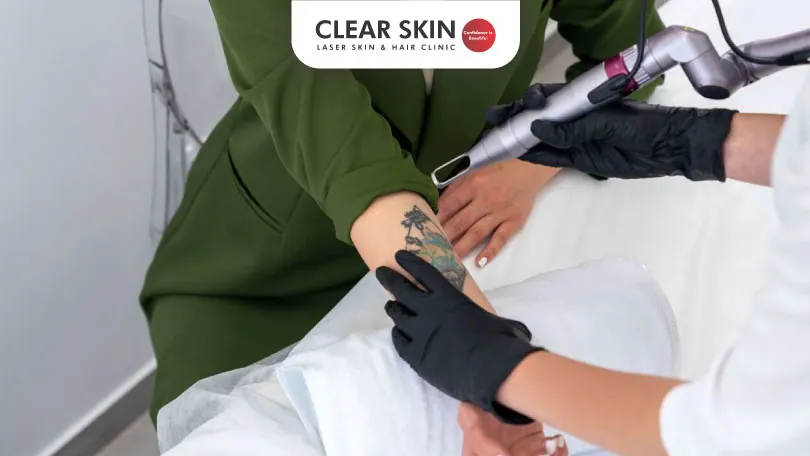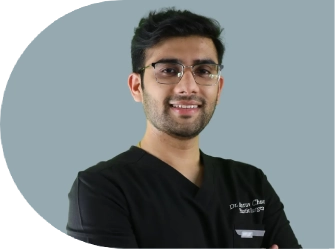Best Method For Tattoo Removal
Reviewed By: Dr. Dhanraj Chavan
Updated on: 10th June, 2023

Do you have a tattoo on your body that you’re regretting? Is it too evident all the time? Or has your ideology from when you’d first gotten the tattoo changed now? Do you wish to be rid of it? Even if only to get a new one, perhaps?!
Well then, let us tell you everything about tattoo removal and then you can make an informed decision.
Table Of Content
- Laser Tattoo Removal
- Seven Factors Affecting Laser Tattoo Removal
- Types Of Lasers
- How Many Laser Tattoo Removal Sessions Are Needed?
- Potential Side Effects
- Other Methods For Tattoo Removal
- Care After Tattoo Removal
- Conclusion
Laser Tattoo Removal
The laser is the best, the easiest, and the most commonly used method for tattoo removal.
It removes the tattoo by breaking up the ink’s pigment into smaller and smaller pieces using short pulses of intense light which pass the top layer of skin harmlessly to be absorbed by the tattoo pigment. The pieces are then removed by the body’s own immune system. After a series of treatment sessions, the tattoo particles are broken up enough to no longer be visible.
- Mechanism:
It works on the theory of ‘selective photothermolysis’, which states that when the appropriate wavelength of light and pulse duration are used to target the tattoo, it will heat the target to the point of destruction, with minimal damage to surrounding skin. While most of these lasers operate on nanosecond, the newer picosecond pulse duration lasers remove tattoos by a photomechanical effect as well, that is by physically fracturing the tattoo particles.
Seven Factors Affecting Laser Tattoo Removal
- The age of the tattoo
- The location on the body (the closer it is to the heart, better are the results of removal)
- The ink colour (black is the easiest colour to treat because it absorbs all laser wavelengths)
- Professional or amateur tattoos (overall, amateur ones are easier to remove)
- The colour of the laser light must be absorbed more by the tattoo pigment than by surrounding skin
- The energy should be sufficient enough to break the specific colored ink pigment into pieces
- The time duration of laser energy must be very short, such that the tattoo is heated enough to fragment, but not so much that the particles dissipate into surrounding skin
Types Of Lasers
Passive Laser Treatment
This is the one commonly available in tattoo parlors and beauty salons. Though cheaper, these passive lasers only partially fade the tattoo, and cannot guarantee complete removal.
Active Laser Treatment
This is expensive, but the most effective and efficient way of completely removing tattoos of almost every color. The active Q-switched laser is the laser of choice, which is of three types: Nd: YAG, Ruby, and Alexandrite.
Each of them target a different range of colour spectrum: Nd-YAG helps remove grey, black, dark blue inks as well as red, yellow, and orange; Ruby removes black and blue pigments successfully; and green colour, which is often left behind, can be removed by Alexandrite laser, in addition to black and blue. In most cases, more than one of these lasers is usually used.
How Many Laser Tattoo Removal Sessions Are Needed?
One treatment session isn’t going to be enough to rid you of your tattoo. A series of sessions will be required, and the number can’t really be predetermined during your first consultation. To avoid the risk of open wounds and skin irritation, the average time between sessions is 4-6 weeks.
Potential Side Effects
- Some redness, swelling, bleeding, raising he tattoo, blisters, and temporary darkening are common after the treatment and usually subside within a couple of weeks.
- The most common side effect is an unwanted change in pigmentation, lightening or darkening of the skin, which could stay permanent, especially if inappropriate wavelengths and pulse duration have been used.
- Scarring, infection, and textural changes of skin are other potential side effects.
Other Methods For Tattoo Removal
Intense Pulsed Light (IPL) Therapy
This uses a broad spectrum light to remove the top layer of skin, breaks down the tattoo ink pigment into smaller pieces, which are then taken care of by the body’s defense system; and the skin regenerates itself in that area. Because the therapy emits larger light pulses, it is suitable for bigger tattoos; but not advisable for dark-skinned individuals, since the permanent loss of colour may occur hypopigmentation).
Cryosurgery
Although less expensive, it not as good a method for tattoo removal as a laser. Here, the tattooed area is frozen using liquid nitrogen, and then sanded through dermabrasion to remove the top layers of skin. The disadvantages are that it is likely to damage even normal tissue, is not suitable for individuals with sensitive skin, and it is also not effective on green and yellow pigments.
Dermabrasion
This method has a high risk of infection and scarring since it abrades the top layers of skin to reach down to the ink-stained skin using a high-speed brush or wheel.
Do-It-Yourself Methods
Though not proven to be very effective, if you wish to go natural, you can try using lemon and honey, apricot scrubs, salt scrubs, chemical peels, etc to remove tattoos. But remember that if it is indeed a permanent tattoo, then it is unlikely to respond.
Care After Tattoo Removal
Irrespective of the technique used for removal, these measures should be followed to escape infection and other side effects, as well as facilitate optimal healing of skin:
- Keep the affected area clean and dry.
- Apply antibiotic ointment 2-3 times a day.
- Keep it covered for the first 2-3 days.
- Avoid taking hot baths.
- Protect it from direct sunlight to prevent pigmentation changes.
- Avoid using any cosmetics, since they can irritate the skin.
Laser therapy and other modalities of treatments discussed above are provided at Clearskin Clinic, under highly qualified guidance and supervision. So do not worry if you’re regretting your tattoo; unlike other mistakes in life, this one can be erased!
For any queries, consultation or treatment, contact us at Clear Skin Clinic.
Do You Know?
Roughly 250 Patients Are Treated
Everyday By These Dermatologists
(You are one click away from flawless skin)
Meet Our Dermatologist!
Conclusion
Further Reading
How to Avoid Acne in Monsoons?
Avoid acne in monsoons with a gentle skincare routine, diet tips, and hydration. Get expert advice to manage breakouts and keep your skin clear and healthy.
Does Makeup Cause Acne-Prone Skin?
Worried about breakouts from using makeup? Does makeup cause acne for you? Learn the safe ways to apply makeup for acne-prone skin.
Morning Skin Care Routine for Glowing Skin
Clear Skin Clinic, led by top dermatologists, shares the ideal morning skincare routine to help you achieve a radiant complexion naturally and effectively.
Monsoon Skin Care Tips for Radiant, Healthy Skin
Clear Skin Clinic, led by top dermatologists, shares the ideal morning skincare routine to help you achieve a radiant complexion naturally and effectively.
Have thoughts? Please let us know
We are committed not only to treating you, but also educating you.





